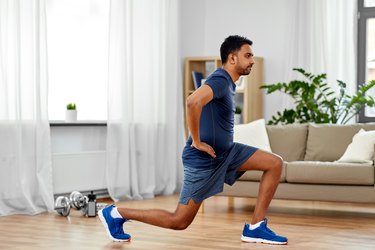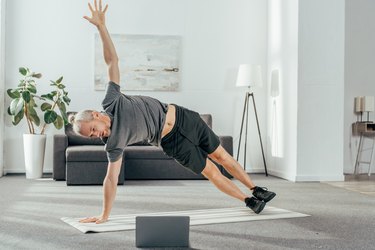

With high-intensity interval training (HIIT) being the hot trend, it's easy to see why many people might confuse the term "low-intensity" to mean ineffective. But that's a major misconception.
While low-intensity workouts won't cause your heart rate to skyrocket like HIIT, they are efficient at burning calories and building lean muscle. Plus, they boast a big bonus for joint health.
Video of the Day
Here's why: Low-intensity exercise allows you to work muscles and joints more consistently throughout their range of motion and properly load tendons, which also helps improve strength and stability in the joints, says Ben Lauder-Dykes, a certified kettlebell instructor and trainer for Fhitting Room.
But gentler on your joints doesn't equal easier. Low-intensity workouts — like this 5-minute full-body routine created by Lauder-Dykes — force you to focus on mastering proper form and using muscle work (not momentum).
This quick body-weight workout doesn't require equipment, just five minutes of your day. It's the perfect way to sneak in some movement during work hours and to combat the stiff muscles that come with sitting too much.
Try This 5-Minute Low-Intensity Total-Body Workout
Great for all fitness levels, including beginners and those with injuries, this routine takes you through four body-weight moves that work multiple muscle groups at once for an especially efficient total-body burn.
And because it doesn't put pressure (or pain) on the joints, you can do it every day whenever you have five free minutes in your schedule.
Do each exercise for the prescribed time, then repeat all the moves once more.
Move 1: Hip Bridge
- Lie down on your back and bend your knees, bringing your feet directly under your knees.
- Push through your heels to extend the hips up into a bridge position. Make sure you keep your chin tucked and ribs down, so you don’t extend through the spine instead of the hips.
- Squeeze your glutes at the top of the movement, then lower your hips back to the ground. Continue for 45 seconds.
“This is a great movement for working the hamstrings and glutes through hip extension, which is especially important for those who sit for long periods,” Lauder-Dykes says.
Move 2: Alternating Reverse Lunges
- Stand with your feet about hip-width apart and your arms at your sides.
- Step your right leg back about 3 feet behind you and bend your knees until they form 90-degree angles. Your back knee should touch the ground and your front thigh should be parallel to the ground.
- Keep most of your weight in your front leg as you press into your left heel and straighten your left leg.
- Bring your right leg back to the starting position and stand up.
- Repeat the motion with your opposite leg and continue alternating for 45 seconds.
If you need a knee-friendly lunge variation, look no further than reverse lunges. They train the quads and glutes while helping to stabilize the knee joint and avoid knee pain, Lauder-Dykes says.
Move 3: Push-Up
- Position yourself on your hands and your knees.
- Step your feet back and straighten your legs so that you're balanced on your palms and toes.
- Check your body and hand position: Your body should make a straight line from your head to your hips to your heels, and your hands should be directly under your shoulders or slightly wider apart.
- From a high plank, bend your elbows at a 45-degree angle to your body and lower your body to the floor.
- Make sure to keep your body in one straight line from your neck through your spine to your hips and down to your heels.
- Press into your palms and push the floor away from you to come back up to a high plank, still keeping your body in one straight line.
- Continue for 30 seconds.
Move 4: Side Plank
- Lie on your right side with your feet stacked (or staggered) and your right elbow under your right shoulder, your forearm along the floor.
- Push through your right forearm and lift your body up so that you're balancing on your right forearm and foot. The more you press your feet into the floor, the more you’ll feel your side abs and not your shoulder.
- Put your left hand on your hip or extend it toward the ceiling.
- Hold for 30 seconds before lowering yourself to the floor.
- Repeat on the other side.
Side planks target your obliques, an important muscle group that helps stabilize the pelvis, Lauder-Dykes says. “Also, while many strength movements create compression front to back, side planks create compression from the side to help offset and reduce the risk of injury,” he adds.
If side planks with straight legs are too intense, try performing the movement with bent knees, he sat. As you gradually build strength and stability, you can advance to the straight-legged side plank.


